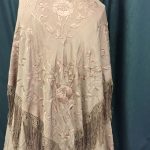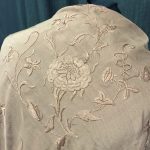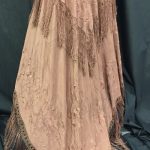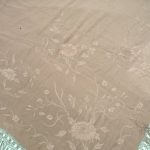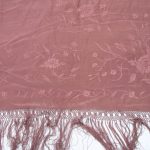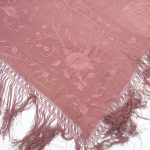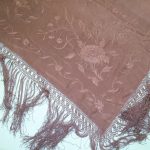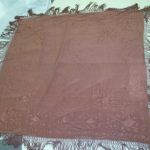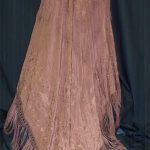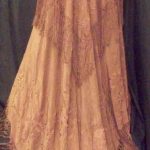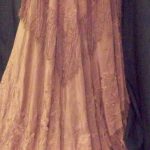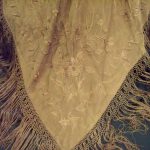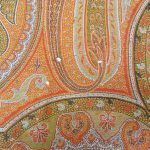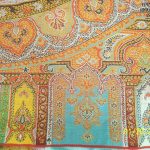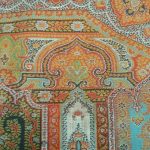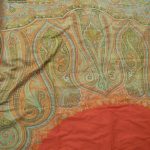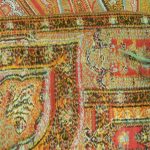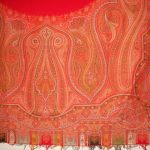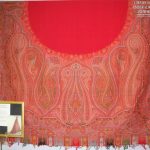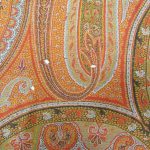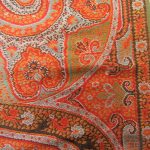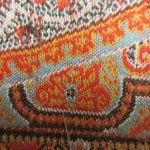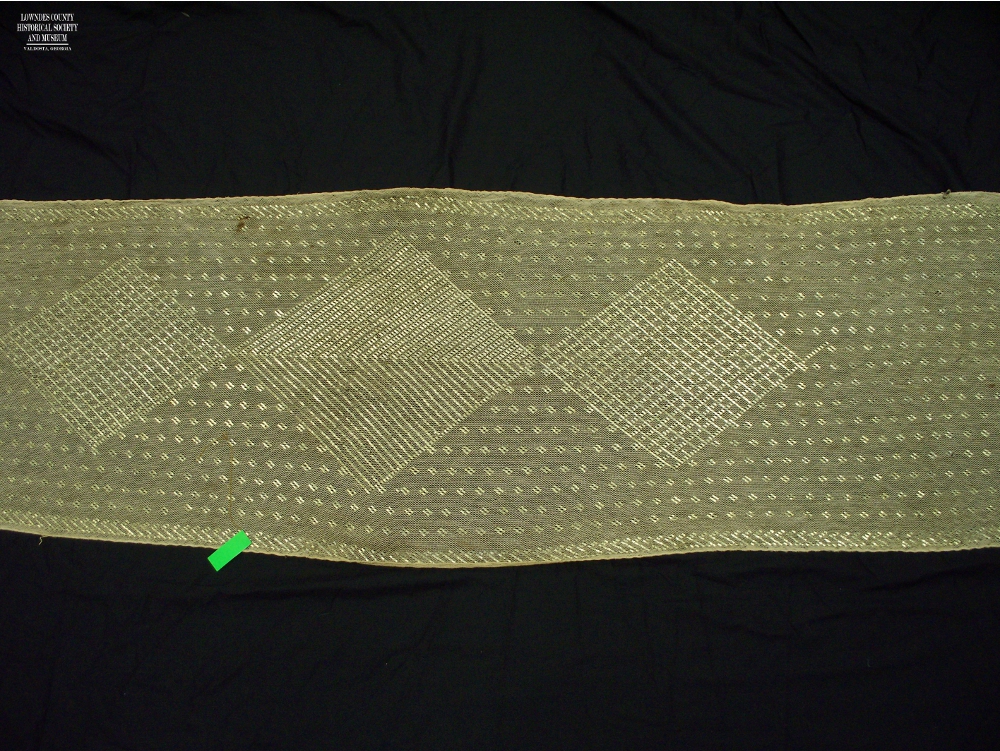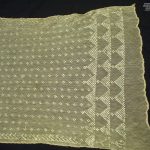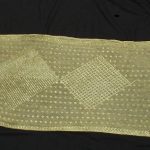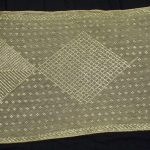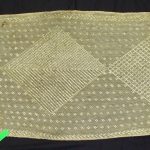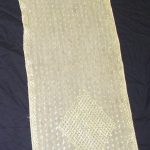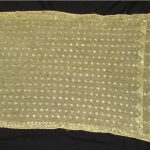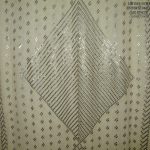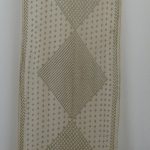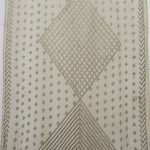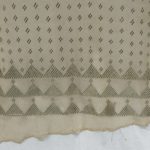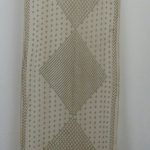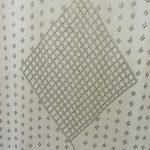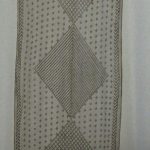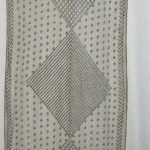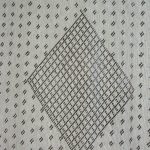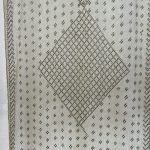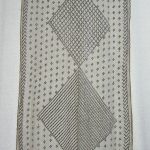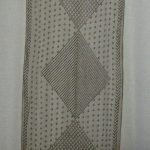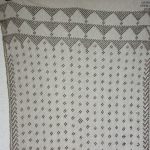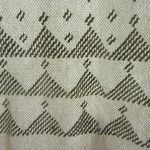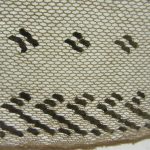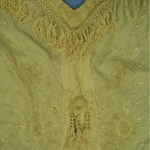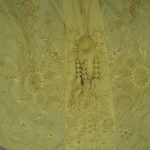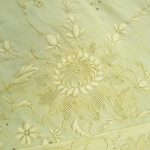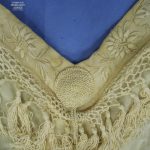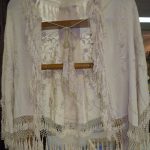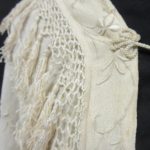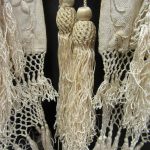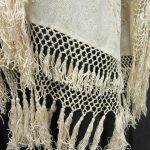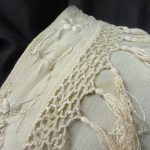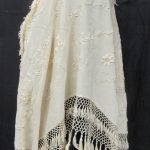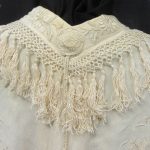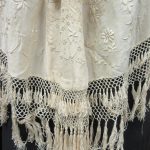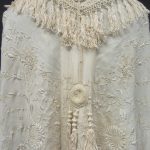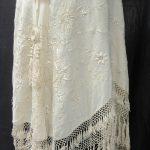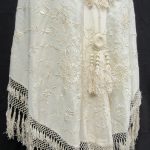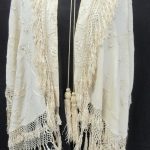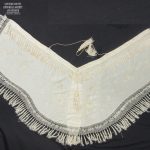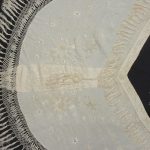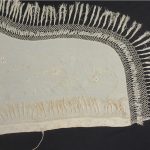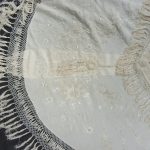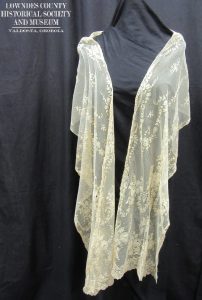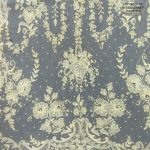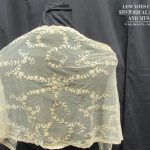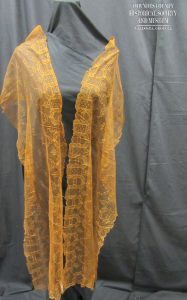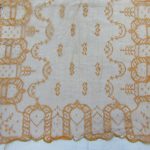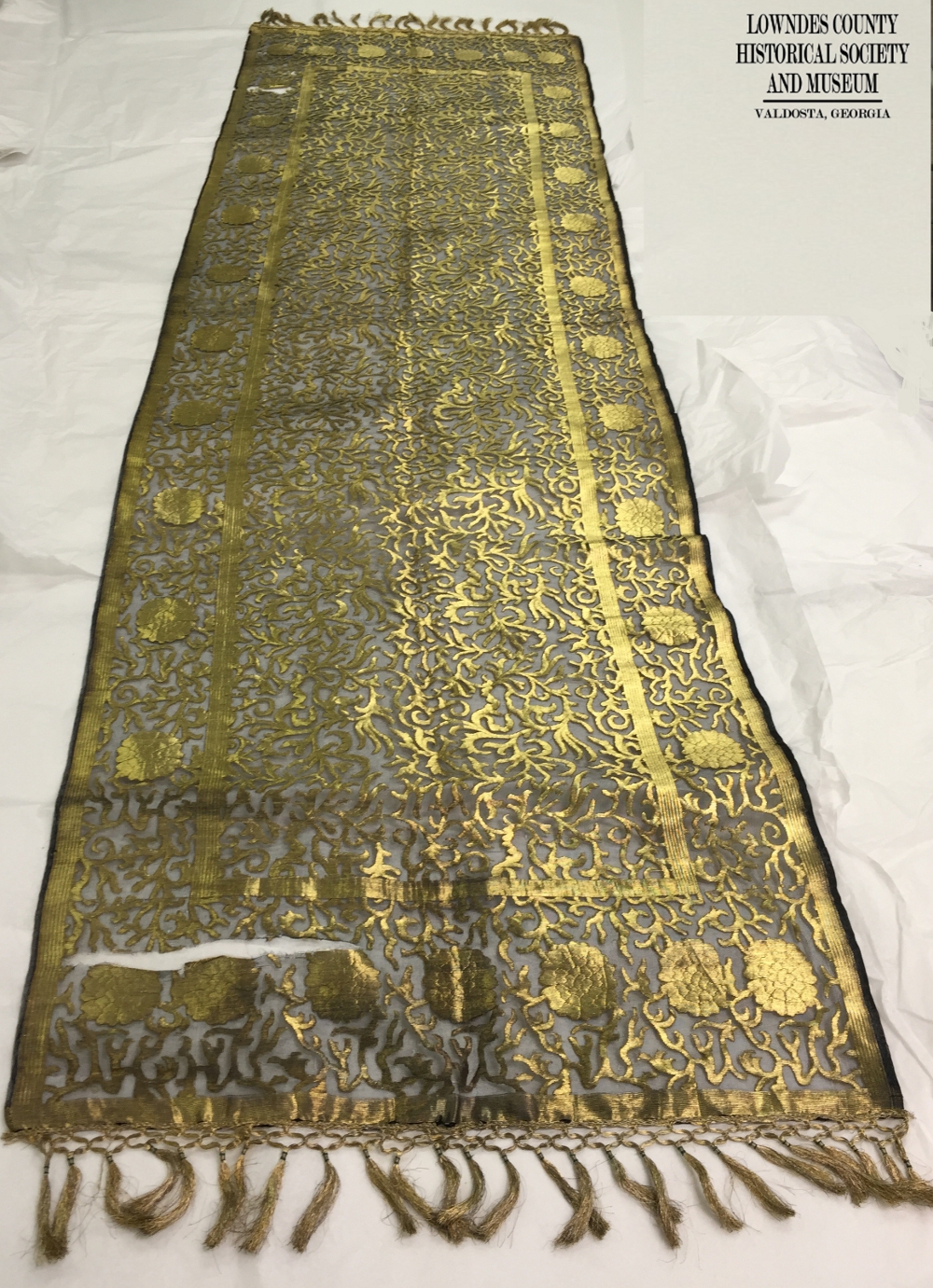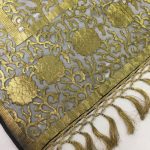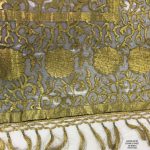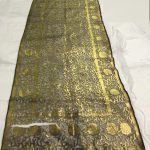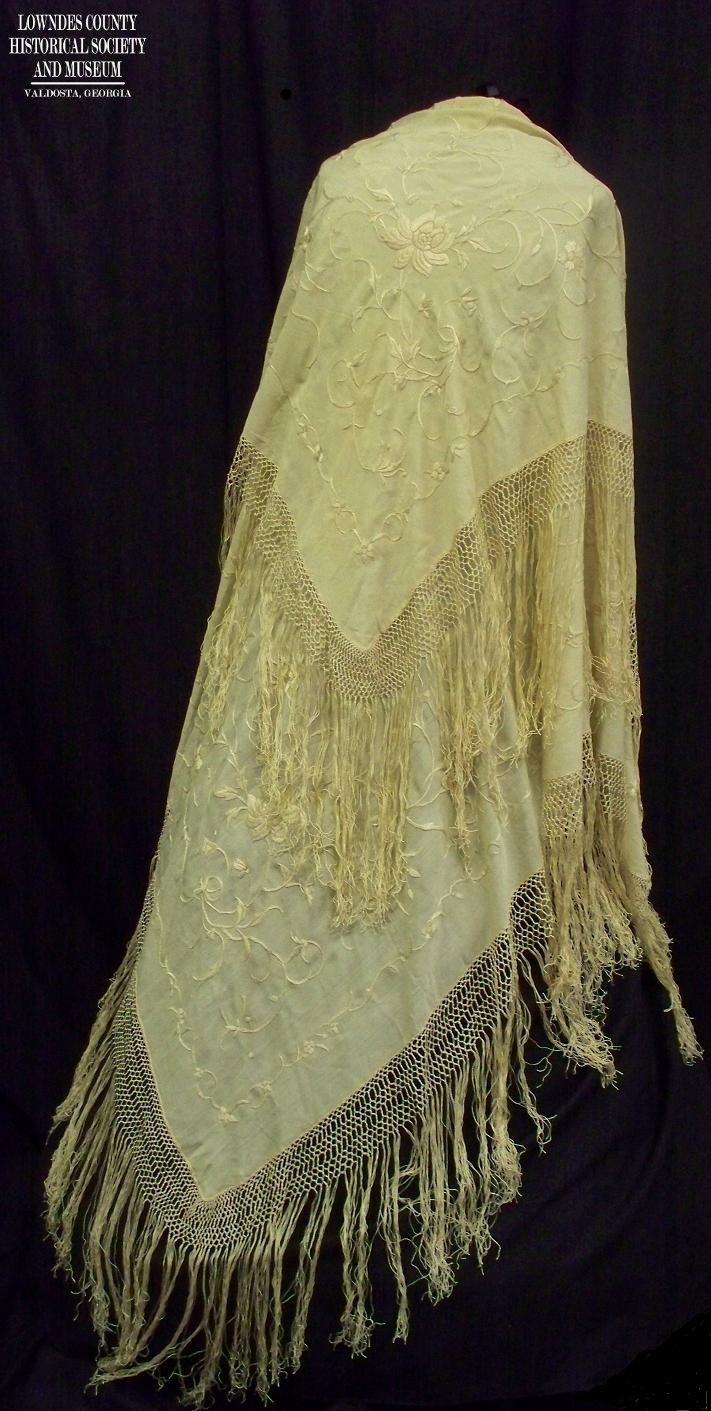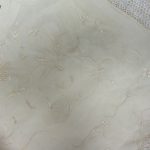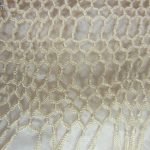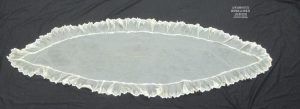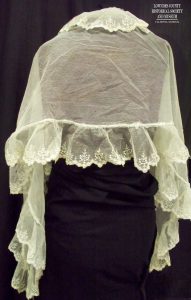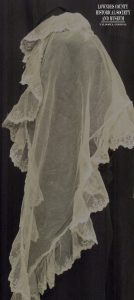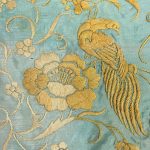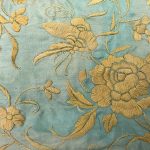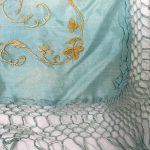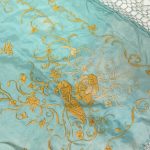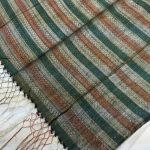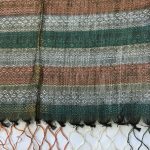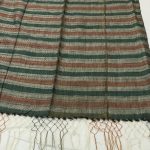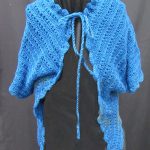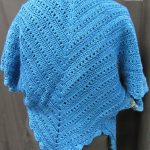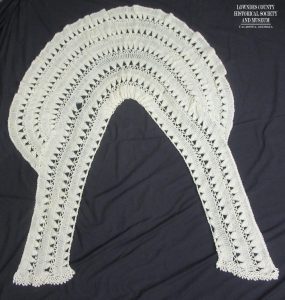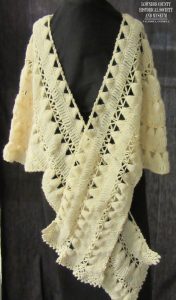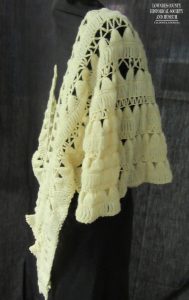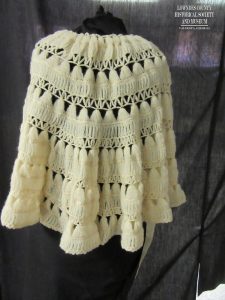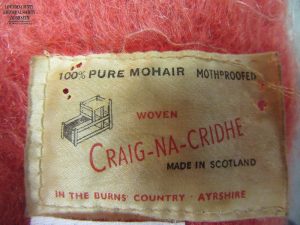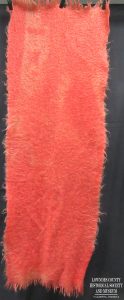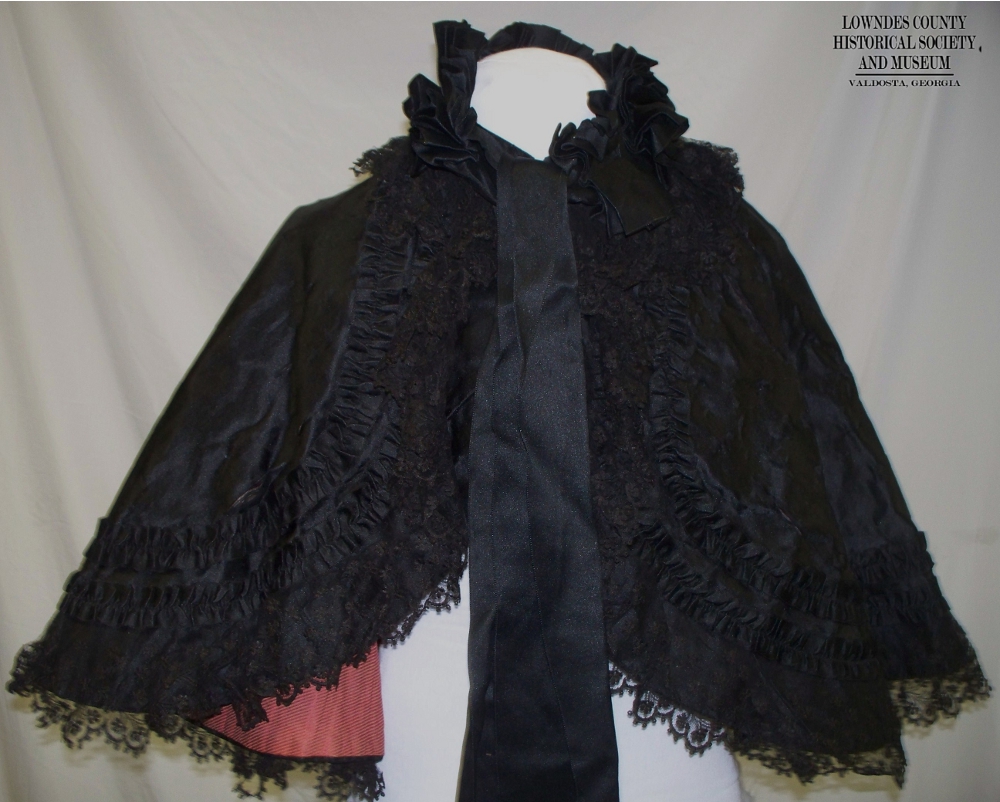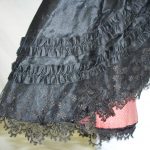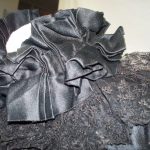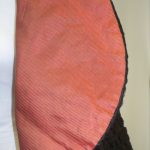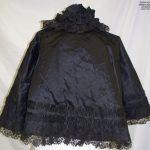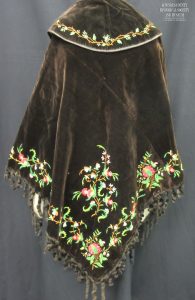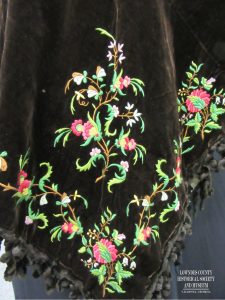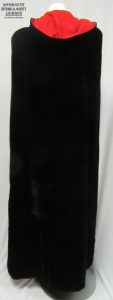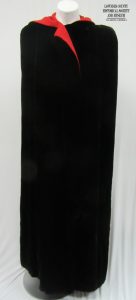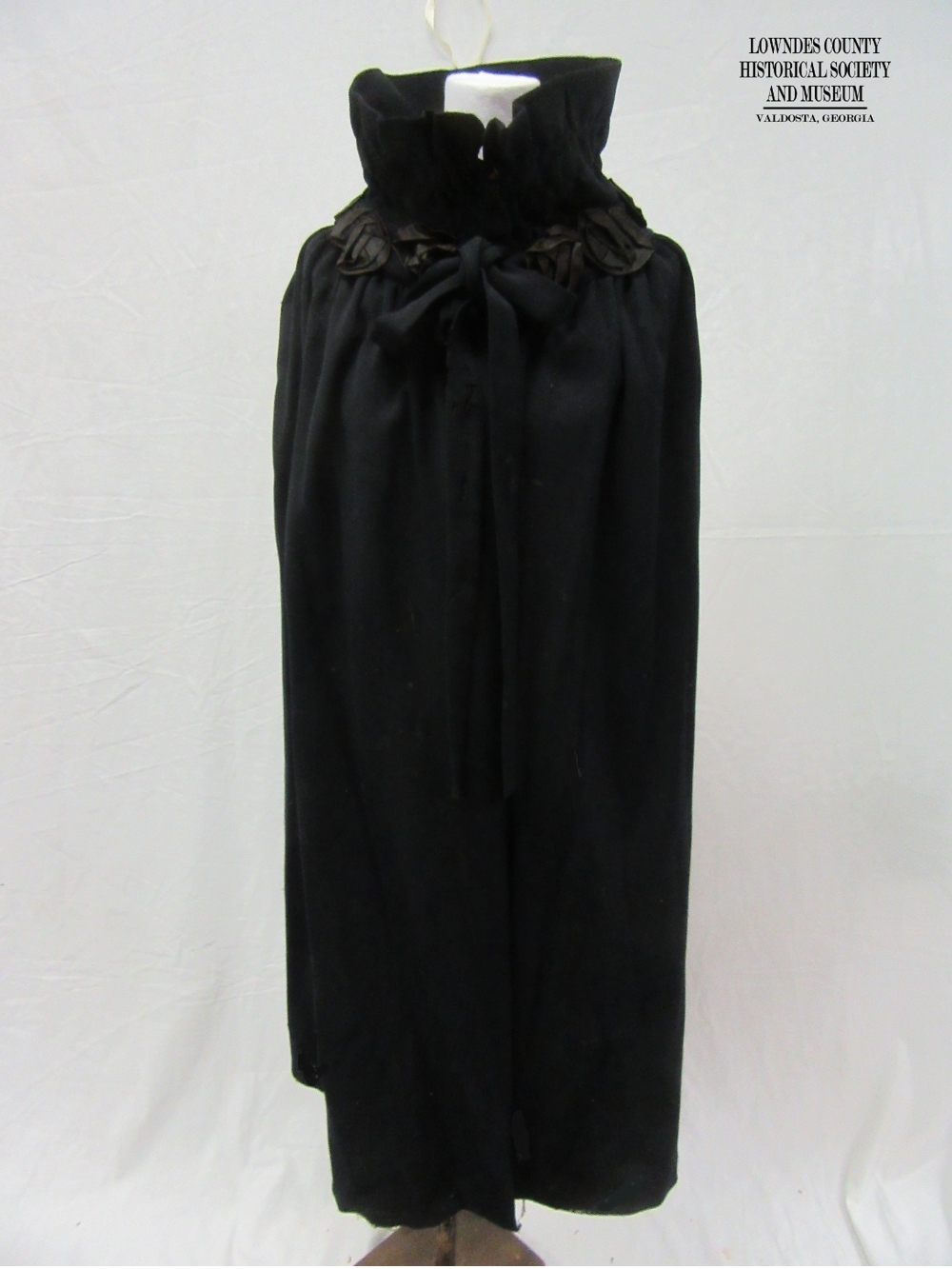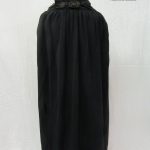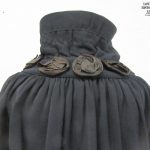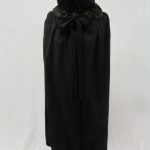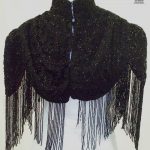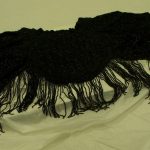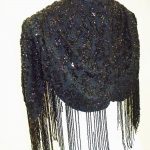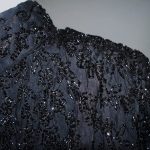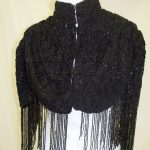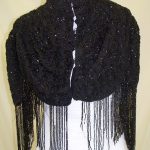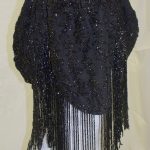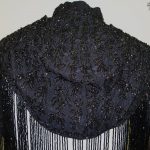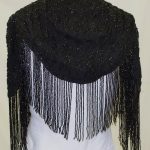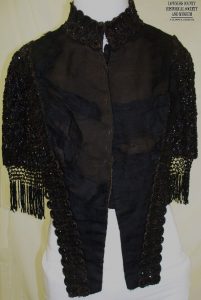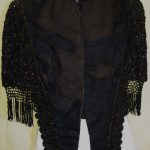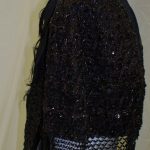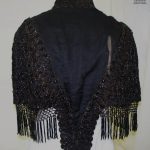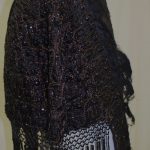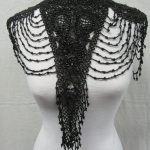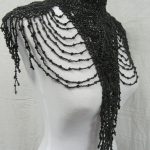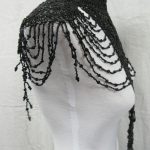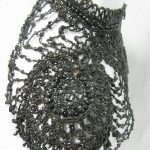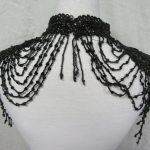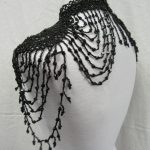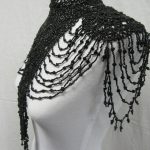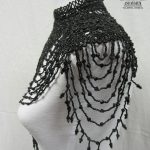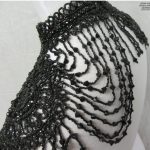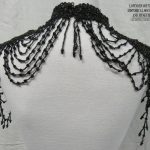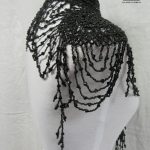Silk Shawl with Silk Embroidery 77-163 TB 74R1Sd1
One of the oldest textiles in the Lowndes County Historical Museum Collection is an 1849 silk shawl with silk embroidery. The handwritten note with the shawl sketched a very interesting history. The original owner was Mary “Molly” Gapen and the item was donated by Mrs. Hank Worley and Miss Marion Worley. It further noted that “A brother of Mary Gapen sent the shawl to her while she was living in Lewistown, ILL. and was off the first ship from China. In 1918 the Gapen sisters who were in California mailed it to Edith Tompkins Worley, the daughter of their deceased sister Mary Gapen.” When the museum staff further investigated the story, it was found that the first gold rush ship from China did arrive in California in 1849. Mary had one brother in the census who would have been old enough to leave his home in Green County, Pennsylvania to go to California; Thomas Gapen who was born May 3, 1833 and was 17 in 1849 and died in 1916. Harriet A. Gapen, a sister of Mary is listed in the San Francisco, California Residence Physicians or Surgeon Occupational Licenses, California Medical College as receiving a diploma in April 25, 1883 and her certificate issued 14 June 1883. Another sister Elizabeth Gapen born 1823 and died Jan. 1, 1906 also lived in California, but died before the shawl was sent to Mary’s daughter. This does; however, confirm Mary’s sisters location in California.
history. The original owner was Mary “Molly” Gapen and the item was donated by Mrs. Hank Worley and Miss Marion Worley. It further noted that “A brother of Mary Gapen sent the shawl to her while she was living in Lewistown, ILL. and was off the first ship from China. In 1918 the Gapen sisters who were in California mailed it to Edith Tompkins Worley, the daughter of their deceased sister Mary Gapen.” When the museum staff further investigated the story, it was found that the first gold rush ship from China did arrive in California in 1849. Mary had one brother in the census who would have been old enough to leave his home in Green County, Pennsylvania to go to California; Thomas Gapen who was born May 3, 1833 and was 17 in 1849 and died in 1916. Harriet A. Gapen, a sister of Mary is listed in the San Francisco, California Residence Physicians or Surgeon Occupational Licenses, California Medical College as receiving a diploma in April 25, 1883 and her certificate issued 14 June 1883. Another sister Elizabeth Gapen born 1823 and died Jan. 1, 1906 also lived in California, but died before the shawl was sent to Mary’s daughter. This does; however, confirm Mary’s sisters location in California.
Mary was born in 1831 to the parents of Zachariah T. Gapan and Margaret. He was born in 1798 in Chest, Clearfield, Penn. and died in Rushville, ILL. the 22nd of October, 1846. Margaret McGeer, his wife and Mary’s mother was born in 1803 and died July 12, 1851 in Miles, Nebraska at age 48. Mary was the oldest of at least 9 children.
Mary Gapan married Dr. Charles Brown Tompkins November 19, 1861 and they lived in Lewistown, ILL where she was a teacher. Her husband, a surgeon, enlisted in the 17th Illinois Infantry May 25, 1861(before their marriage) and was mustered out June 4th, 1864 to reenlist with the 55th Illinois Infantry December 7th, 1864 in Savannah, Ga and was mustered out in Little Rock, Arkansas. During his service in the Civil War, he was stationed at Vicksburg and wrote many letters home to his wife.The collection of letters is housed at Duke University. A photograph of Mary “Molly” Gapen Tompkins can be found in the book Vicksburg: 47 Days of Siege by A.A. Hoehling.
After the war Mary and Dr. Charles Thompkins had at least four children; Charles Wilmer born Aug 21, 1866 died 1948., Mary born. Oct 3, 1868 died in 1886, Margaret Edith (later references refer to her as Edith Margaret) born Oct 27, 1870 died 1962, and Henry Augustine born 1873 died 1873. Mary “Molly” Gapan Tompkins, the shawl owner also died in 1873, at the age of 41. The shawl was sent to Edith Margaret Thompkins; the third child listed, who married Ollie A. Worley. Edith and Ollie Worley had at least two children, Marion and Charles Leon Worley. Miss Marion Worley, a granddaughter of Mary Thompkins from Jasper, Fl. is listed on the acquisition along with Mrs. Hank Worley. Charles Leon Worley (b. 1897 d.1985) married Hallye Bamberg (1899-29 Dec. 1976 , Lowndes County) in Valdosta August 23,1922. Leon Charles Worley worked in Valdosta (at age 43) as the Chief Clerk of ACL freight train and lived at 614 N Ashley Street and later made their home at 110 W North in Valdosta. They had a son named Charles Leon Jr that was killed in North Korea in 1950.
The museum was able to trace how a shawl from China to California in 1849 made its final destination in 1977 to the Lowndes County Historical Museum.
Dr. Charles Brown Tompkins remarried several times and died September 17, 1913 in Hamilton County, Fl. Mary Gapen Tompkins the original owner of the shawl is buried in Oak Hill Cemetery in Lewistown, Fulton Co., ILL.
Fiber: Silk
Size: 60”w X 60”l measurements to do not include the 8’ fringe, knotted in groups of three done by hand, floral silk embroidery 10” border, with 8” floral medallions in corners, field plain
Color: originally white and dyed “garnet” many years ago
Please click on the photos below to view a larger image.
Paisley Shawl 1980-290 TB74R1Sd1
Another interesting woven textile is a multicolored wool paisley shawl. This paisley shawl was worn for warmth in high fashion at the beginning of Valdosta’s history. The enormous woven shawl measures over 10 feet long and 5 feet wide. Paisley is an old design due to its ability to adapt to changing styles; however during the reign of the crinoline skirts (1840-1870), huge paisley shawls became very popular to wear folded at the corner and over the back of the long flowing dresses. During this high paisley period, the new jacquard loom was utilized which made it possible to increase the size and intricacy of the design. Queen Victoria purchased several paisley shawls in 1842 preferring the long shawls over the square style which added to its popularity. However, by 1870, a large bustle and short jacket or smaller shawl emphasized the ornately decorated bustle and the largest paisley shawls gave way to a smaller rectangular form.
It is also interesting to note that the specific jacquard looms on which the large paisley shawls were woven, no longer exist. They were ether adapted for other jacquard uses or were destroyed after the fall of the large paisley shawl in 1870.
Unfortunately no family history was noted in this acquisition. It was donated to the museum by Mrs. Virginia Green Sparkman in 1980. If anyone has any documented family information on this item, please help us keep our history by sharing it!
Fiber: Wool
10′ X 5′
Assuit Shawl 1985-455-36 TB71R2Sc1
This textile technique is called Assuit or Asyte named after the city of origin Asyut in Upper Egypt and is made with metal ribbon that is hand embroidered or “woven” between the holes of the cotton netting with a blunt ended double holed needle to form the decorative pattern. (Please note the various spellings of this textile comes from the difficulties of translating Arabic into English). This technique is also referred to a descriptive term tulle-bi-telli meaning plated mesh or net with metal. The results is a fluid, weighted textile that drapes beautifully and reflects light when worn. The pieces are usually structurally simple in order to display the pattern of the metal stitches.
Although this is an ancient technique, it was first sold in the United States in the Chicago Exposition in 1893. However, this particular shawl as well as an assuit dress in the museum collection was donated by Caroline Stump Butler and dates from her mother Marion Wilkinson Stump (1889-1974). Before marriage, Marion Wilkinson took a Grand Tour of Europe and the Holy Land with other Valdostans in 1912. The shawl and dress, no doubt, were purchased in Egypt along this trip since the back of a postcard Marion Wilkinson sent home, now archived in the museum, states that they were off to Cairo, then to Luxor. Assuit is right between these two cities and they would have traveled through this area. Caroline Stump Butler donated the postcards from her mother’s trip along with a sterling silver metal chain purse with her mothers name inscribed on the clasp. More information on this Grand Tour can be found in the museum’s newsletter January-February-March 2012 at https://valdostamuseum.com/wp-content/uploads/2013/04/Jan-Feb-Mar-2012-Newsletter.pdf. More information on Caroline Stump Butler can be viewed on our website at https://valdostamuseum.com/collections/textiles/red-cross-textiles/
Materials: Cotton, metal
19″W X 89″L
Made in Egypt
Silk Ivory Shawl Eager Collection 2017-25-17 TB 23 R6Sf3
This shawl was given to the museum by Robert Eager and Josefa Beadle and was from the estate of George Eager and his wife Dorothy Hopkins Eager. However, it could have also belonged to Juliette M. Guilloteau (b.6 Feb 1887, d. March 1983) who was a native of France and was the governess for Dorothy and her children.
The shawl/cape dates circa 1910 and although it is not an original design is embroidered by hand with ivory silk thread . This U-shaped shawl features a large box pleat down the center back and is decorated by three dimensional circular shaped silk trim. A double braid then continues down to the middle of the center back with another trim similar to the first and is finished with 3 long wrapped and skirted tassels. The front opening is hemmed with an elaborate 1 1/2inch embroidery and trimmed with fringe that ends in small tassels. Two cords that end in tassels are used for ties to close the front at the neckline. The hem of double row fringe is attached by hand and then braided followed by ties with smaller tassels and echoes the single row of fringe and tassels at the front opening and neckline. The garment is then elaborately embroidered using padded and raised stitching, French knots, eyelet stitch, lace stitches, satin stitches and bullion stitches, and filling stitches to name a few. Yet because of the ivory on ivory color, the shawl is not busy but coveys an elaborate elegance. This shawl would make a good study in embroidery, tassel and fringe techniques as well as a design study in light and texture.
27″ tall from in the center back to end of fringe;
70″ wide from left front to right front including fringe;
Fringe is 6 ½ in long and is a double fringe with 3 rows of braiding followed by a 1 in tassel with several of the tassel strings attached to the next row of a set of 3 braiding 3 ½ tassel.
Pleat down the center back is 4 ½ in wide at the bottom and 2 ½ in wide at the top.
Two Lace Shawls Eager Collection 2017-12-24, TB 13R6
-24, Ecru lace shawl, handmade needle lace on netting made w/chain stitch and lace fillings, 13 ½”w x 84” l
-25, Brown [copper] lace shawl, machine made lace netting, 13” w X 86”
Metallic Gold and Black Shawl UNK #3 TB23R6Sf3
This ornate shawl has a background of very fine black netting with a flat gold braid and gold work trim with tassels and is circa 1920’s.In this technique the very fine rectangular black netting contains two threads which are twisted and joined together at each intersection. The flat gold braid, which is less than an 1/16″ wide is then woven though one of the threads leaving the other thread of the black netting under the gold flat braid. The gold was then brought to the back and simply cut off where the pattern stopped The museum is still searching for historical information on this item. This item is scheduled for conservation assessment in the near future.
Size: 22″ W X 78″ long
Fringe: gold work 1 1/2 ” knotted and ending in tassels
Cream Colored Silk Embroidered Shawl Marie Crockett Collection
Acq #1978-193-02a TB 23R6Sf3
This cream colored silk embroidered shawl (piano scarf) was given to the museum by Marie Crockett, who taught dance in Valdosta. This shawl dates circa 1860 and is hand-embroidered with silk cornet thread in a floral design with the corners alternating the design. The 11 inch fringe is hand-knotted and hand sewn with 2 1/4 inches of knotting in groups of two.
Silk
Size 66″W X 72″ L
Ecru Net Shawl UNK #1 TB23R6Sf3
 This summer plain net shawl is circa 1900-1920. The shawl is made simply from cotton netting in a narrow elongated oval with pointed ends and 3 1/2 inch wide gathered netted machine embroidered lace whipped to all edges, resulting in a delicate airy design. The manner in which lace is stitched onto the netting suggests it could have been worn two different ways, the way shown here around the shoulders and draped softly over the front or simply folded in half length wise, carried around the back and simply draped around each arm at the elbow. The museum is still looking for information pertaining to the history of this shawl.
This summer plain net shawl is circa 1900-1920. The shawl is made simply from cotton netting in a narrow elongated oval with pointed ends and 3 1/2 inch wide gathered netted machine embroidered lace whipped to all edges, resulting in a delicate airy design. The manner in which lace is stitched onto the netting suggests it could have been worn two different ways, the way shown here around the shoulders and draped softly over the front or simply folded in half length wise, carried around the back and simply draped around each arm at the elbow. The museum is still looking for information pertaining to the history of this shawl.
Fiber: cotton
20″ W X 67″ L.
Turquoise Silk Shawl with Gold Embroidery Marie Crockett Collection 1978-193-02b TB23R6Sf3
This square turquoise silk shawl with tan embroidery also has knotted fringe like the cream colored one above both of which were given to the museum by Marie Crockett. This fringe on this shawl is 7″ long with the knotting at 1 5/8″ from the fabric. The beautiful gold silk embroidery has motifs of birds, butterflies, and flowers. No historical information was found on this item.
Fiber Contents: Silk
Size 44″W X 44″L
Multi-colored Shawl UNK #2 TB23R6Sf3
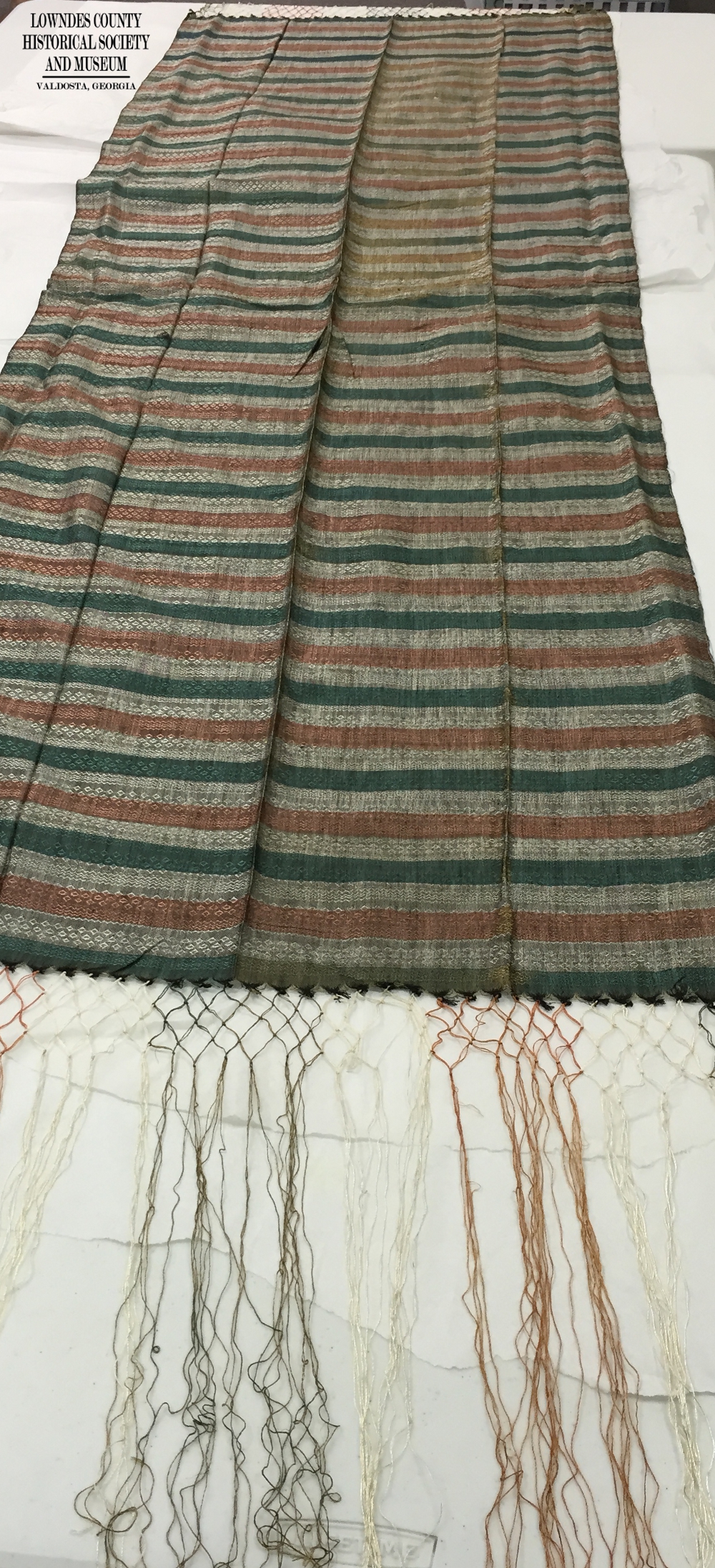 This shawl is made from synthetic materials. The long fringe has 3″ of knotting. Unfortunately there is severe creasing and sun fading damage to this particular piece as can be seen in several of the photos. This piece’s design elements is use of color with the rose path weave structure. The length of this piece and the 16″ long fringe complements the fluid draping and elegance of the green, copper and silver colors. The museum staff is still searching for more information on this piece.
This shawl is made from synthetic materials. The long fringe has 3″ of knotting. Unfortunately there is severe creasing and sun fading damage to this particular piece as can be seen in several of the photos. This piece’s design elements is use of color with the rose path weave structure. The length of this piece and the 16″ long fringe complements the fluid draping and elegance of the green, copper and silver colors. The museum staff is still searching for more information on this piece.
Size 29″W X 114″L
Royal Blue Crochet Shrug UNK #4 TB23R6Sf3
This hand crochet shrug has a scalloped edging, tassel tie. At this time no information on it has been found.
.
Crocheted, Cream Colored Marie Crockett Collection 1978-193-04,TB23R6Sf3
This shawl again belonged to Mrs. Marie Crockett. It is constructed of two pieces; piece 1 forming main structure of shawl consists of three rows of linear lacy pattern; piece 2 forming back of shawl consist of three rows of the same linear lacy pattern attached to piece 1 in a semi-circular form centered on 54” of piece 1. The yarn used to make this shawl is a plain acrylic/metallic yarn.
68” long measured from left front tip to right front tip, 19″ length from center back to bottom of shawl
Red Shawl Marie Crockett Collection 1978-193-14,TB23R6Sf3
This fuzzy woven mohair shawl bears a tag that says: “100 % Pure Mohair, MOTHPROOFED, Woven, Craig-Na-Dridhe, Made in Scotland, In the Burns Country, Ayrshire.” Mohair comes from a goat with long curly lustrous staples. Unfortunately, there is also some light damage on this shawl as well.
25” w x 72” long + 2 ½” fringe on each end for a total length of 77”
Capes
Black Silk Cape Montine B. Abildgaard Collection 1980-286-09 TB 2 R2Se1
This beautiful black silk cape from the late 1800’s features a standing collar of pleated silk ribbon followed by a row of the black scallop lace and a row of pleated ribbon. The front is decorated with a wide scalloped black lace echoing two rows of wide gathered satin ribbon. This cape is fully lined on inside with a bubble gum pink ribbed silk. This cape is 21 inches long.
This was donated by Montine B Abildgaard who was born May 15, 1921 and died December 15, 2011. Her obituary says was born in Kinderlou. This cape looks as though it is circa 1880 so it must have belonged to someone in her past. Other items in the acquisition were also dated around circa 1880’s. Her parents were Shennie (1881-1961)and Martha Townsend Bass ( 1886-1963). John L Townsend and Nancy Loraine (1864-1908)Townsend from Pinetta, Florida were Montine’s maternal grandparents. Therefore, This could have belonged to her grandmother.
Brown Cotton Velvet Cape Marie Crockett Collection Acq #1978-193-1-06 TB 82R1Sc2,
This brown cotton velvet cape has a cream silk lining, chenille trim, and multi-colored crewel machine embroidery. It features a six inch wide collar in back. The center front measures 35 ½” long and the chenille trim is 3” long. The embroidery is 6” wide on the bottom and 1 ½” wide on collar. Bottom circumference is 101 inches. Unfortunately, the inside lining of this cape is in poor; however, the exterior cape of the cape is in good condition. Until this item can be stabilized, it can not be put on display.
Black Velvet Full Length Cape Acq#2010-007 TB82 R6Sf1, Mala Vallotton
This black velvet full length cape boasts a red wool lining and a generous hood. In 1939-1940 it belonged to Jane Ann Crittendon Young, mother of Mala Vallotton, of Valdosta, and was worn to dances in college. The 1 1/2″ red button on inner side,and the 1 ½” black button on outside serves as closure. The center front is 54” long, hem circumference 72 ½”. [Wedding dress of Jane Ann Crittendon in TB 97 see Wedding Dresses and Special Occasions on this web site
Wool cape with Rosettes TB221982-86, possibly Abilgaard
This wool gabardine black full length cape has a round yolk and a 5” stand -up collar which closes with large buttons that are missing and self-fabric loops and a tie on each side at the neck. Fashioned black ribbon roses encircle neck, and is finished on the inside with an off-white silk lining. It is machine made and measures 42 ½” to the hem. This piece is scheduled for conservation assessment.
Beaded Pieces
Jet Beaded Black Silk Cape Tb49R1Sc2
 This late Victorian period 1889-1894 cape contains elements for a very elegant piece including black silk and jet beads. The beading is sewn in vertical rows of cylinder cut beads in a leaf vine pattern. A standing 1 1/2″ wide collar is decorated with a sewn beaded leaf design and a beaded scroll bordering the neckline. Five petals make up the whole basis of the cape pattern with one petal on each center front, one for each sleeve, and one for back. Back and front petals are pleated in one inch pleats into the collar while the sleeves are gathered and are slightly full. A beaded scroll also decorates the border of each scalloped petal. To finish the look, six inch long jet beaded fringe adorns the front scallops while eight inch long jet beaded fringe adorns the back and sleeves which gives the whole garment a very nice draping while balancing the design overall. The heavily beaded cape is supported and shaped with facing lined in black silk. Unfortunately, the museum is still looking for information on whom this might have belonged to and for what occasion it was used. This item is scheduled for assessment and conservation before it can be displayed.
This late Victorian period 1889-1894 cape contains elements for a very elegant piece including black silk and jet beads. The beading is sewn in vertical rows of cylinder cut beads in a leaf vine pattern. A standing 1 1/2″ wide collar is decorated with a sewn beaded leaf design and a beaded scroll bordering the neckline. Five petals make up the whole basis of the cape pattern with one petal on each center front, one for each sleeve, and one for back. Back and front petals are pleated in one inch pleats into the collar while the sleeves are gathered and are slightly full. A beaded scroll also decorates the border of each scalloped petal. To finish the look, six inch long jet beaded fringe adorns the front scallops while eight inch long jet beaded fringe adorns the back and sleeves which gives the whole garment a very nice draping while balancing the design overall. The heavily beaded cape is supported and shaped with facing lined in black silk. Unfortunately, the museum is still looking for information on whom this might have belonged to and for what occasion it was used. This item is scheduled for assessment and conservation before it can be displayed.
Fiber content: Silk interlining, silk crepe outer fabric, jet beads
Black Silk Cape With Beads In S Design
UNK #3 TB 49R1Sc2
Beaded Fringe Scallop Cape- This could be one of the following Acqs 1980- 286 Abilgard “ Black cape”,or 1978-193,203-03 Crockett silk cape. This beauty is made of silk with heavy beading in an S shape. The high collar is also beaded the front closes with large hook and eyes. The front is 17 inches long and tapers to 3″ wide on each side of center front when closed. The back is also 17 inches long and has tapers to 3 ” wide. The beaded fringe is a elegant 3 1/2″ long. This piece is very fragile due to silk degradation and can not be exhibited until conservation to stabilize this piece is executed.
Jet Beaded Necklace/ Capelet Acq 1972-53-18 Tb49R1Sc2, Mrs. Jerome Tillman
 This elaborate jet beaded necklace worn over a blouse is in contrast with the capelet shown above since it is constructed with the absence of a ground cloth; however, the design seems to indicate it was made around the same time period. The high collar is a 15 ½” neck, the center front length 17”, and the neck/shoulder length/arm 13”, with the back length 4 ½”. The design employs different shapes & sizes of jet beads to form dense patterns over shoulders, neck, and center front in a deep V. Lighter draped patterns connect center front to shoulders and shoulder to back. The varying shapes also reflect the light differently adding more contrast to the monochromatic design.
This elaborate jet beaded necklace worn over a blouse is in contrast with the capelet shown above since it is constructed with the absence of a ground cloth; however, the design seems to indicate it was made around the same time period. The high collar is a 15 ½” neck, the center front length 17”, and the neck/shoulder length/arm 13”, with the back length 4 ½”. The design employs different shapes & sizes of jet beads to form dense patterns over shoulders, neck, and center front in a deep V. Lighter draped patterns connect center front to shoulders and shoulder to back. The varying shapes also reflect the light differently adding more contrast to the monochromatic design.

